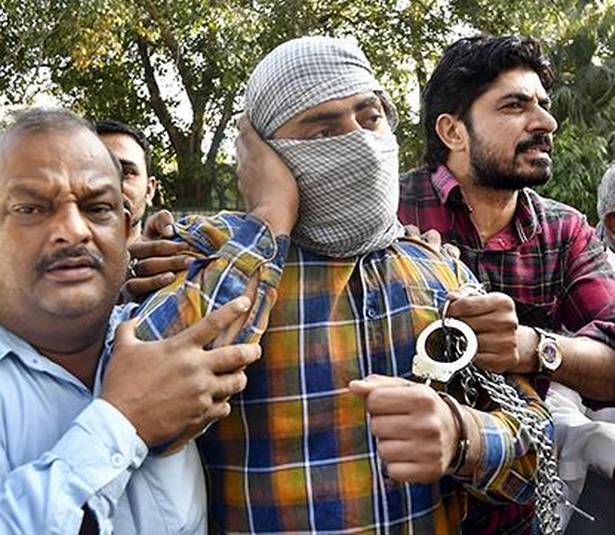
Delhi Police on Friday filed the first charge sheet over the February rioting in north-east Delhi, naming three men including Shahrukh Pathan, a man who was pictured pointing a pistol at a policeman in the Maujpur neighbourhood.
The 350-page charge sheet was filed in the Karkardooma court against Pathan, 23 and two others who were arrested by the crime branch’s Narcotics Cell, said a senior police officer, adding that the three remained in jail.
According to the charge sheet, Pathan was the first person to be formally arrested in connection with the Delhi riots after being booked by the Jafrabad police. He was initially booked for attempt to murder, assault on a public servant, disobedience of an order passed by a government servant and under the Arms Act.
“During investigations, we also added IPC {Indian Penal Code} sections pertaining to rioting with a deadly weapon, unlawful assembly of people guilty of an offence with a common intention, and harbouring an offender,” the senior police officercited above said, requesting anonymity.
The last section was pressed against Kaleem Ahmed, a resident of Kairana and friend of Pathan’s, who allegedly provided Pathan a safe house during his days on the run. Ahmed was arrested during the investigation.
Pathan, a resident of Ghonda in north-east Delhi, was arrested from Shamli in UP on March 3 after allegedly remaining in hiding for over a week since he was caught on camera, said the officer. The weapon he allegedly used to fire three rounds and then point at a policeman was a 7.65 mm pistol, said the officer. “We had recovered the pistol and two live rounds from Pathan,” said the officer.
None of three rounds Pathan is allegedly to have fired on February 24 hit anyone, said the officer about the investigation.
The third person to be charge-sheeted in this case is Ishtiyak Mallik, also a resident of Ghonda. “Our investigation found Mallik to be rioting with Pathan during the time he fired,” said the officer.
“Pathan is the son of an alleged local drug peddler of north-east Delhi and was released from jail on bail in one such case just weeks before the riots,” said another officer.
While the father has multiple drug-related cases registered against him at various police stations in north-east Delhi, the shooting in north-east Delhi was Pathan’s first known criminal act, said the officer.
On the first main day of the riots, on February 24, Pathan was caught on camera allegedly pointing a pistol at a head constable, Deepak Dahiya. While no one was hurt in that confrontation, police said Pathan had managed to escape from the scene of the rioting.
Pathan’s photographs also revealed that guns were being used by rioters. Thereafter, rioters had a free run with firearms, leaving many dead and several others with gunshot wounds. At least 53 persons were killed in the rioting.
While the police went onto file nearly 700 first information reports (FIRs) and detain or arrest over 2,200 suspects, they have come in for criticism from many quarters for allegedly arresting more Muslims than Hindus and booking them under stringent laws such as the Unlawful Activities (Prevention) Act. The police have maintained that their probe has been “sincere and impartial”.
“All the arrests have been made based on scientific and forensic evidence, including video footages and technical evidence,” said a police statement.
The riots started as clashes between opponents and supporters of the Citizenship Amendment Act (CAA) before acquiring a communal colour.